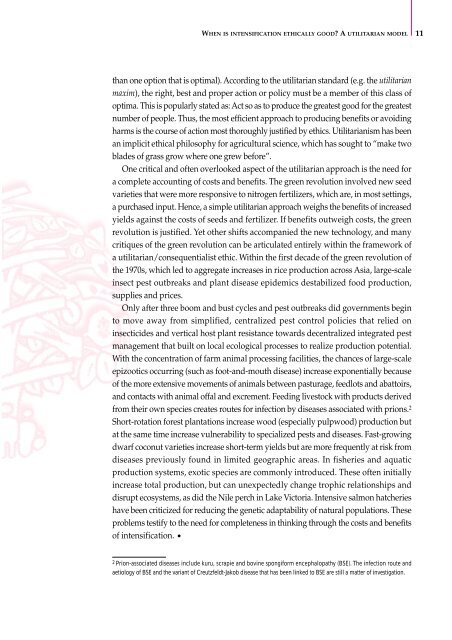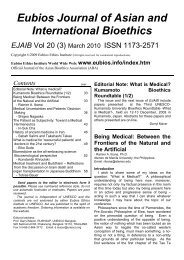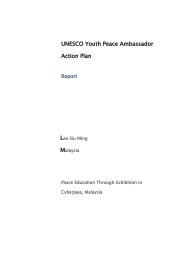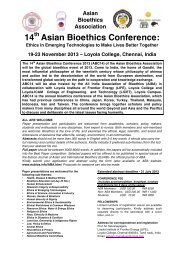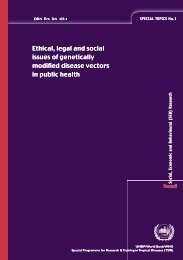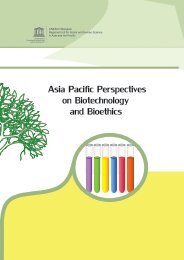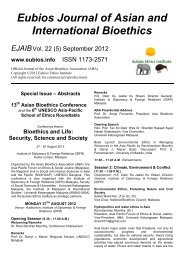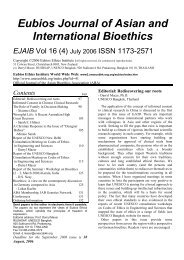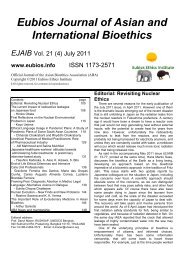Ethics of Sustainable Agricultural Intensification - FAO.org
Ethics of Sustainable Agricultural Intensification - FAO.org
Ethics of Sustainable Agricultural Intensification - FAO.org
You also want an ePaper? Increase the reach of your titles
YUMPU automatically turns print PDFs into web optimized ePapers that Google loves.
WHEN IS INTENSIFICATION ETHICALLY GOOD? A UTILITARIAN MODEL 11than one option that is optimal). According to the utilitarian standard (e.g. the utilitarianmaxim), the right, best and proper action or policy must be a member <strong>of</strong> this class <strong>of</strong>optima. This is popularly stated as: Act so as to produce the greatest good for the greatestnumber <strong>of</strong> people. Thus, the most efficient approach to producing benefits or avoidingharms is the course <strong>of</strong> action most thoroughly justified by ethics. Utilitarianism has beenan implicit ethical philosophy for agricultural science, which has sought to “make twoblades <strong>of</strong> grass grow where one grew before”.One critical and <strong>of</strong>ten overlooked aspect <strong>of</strong> the utilitarian approach is the need fora complete accounting <strong>of</strong> costs and benefits. The green revolution involved new seedvarieties that were more responsive to nitrogen fertilizers, which are, in most settings,a purchased input. Hence, a simple utilitarian approach weighs the benefits <strong>of</strong> increasedyields against the costs <strong>of</strong> seeds and fertilizer. If benefits outweigh costs, the greenrevolution is justified. Yet other shifts accompanied the new technology, and manycritiques <strong>of</strong> the green revolution can be articulated entirely within the framework <strong>of</strong>a utilitarian/consequentialist ethic. Within the first decade <strong>of</strong> the green revolution <strong>of</strong>the 1970s, which led to aggregate increases in rice production across Asia, large-scaleinsect pest outbreaks and plant disease epidemics destabilized food production,supplies and prices.Only after three boom and bust cycles and pest outbreaks did governments beginto move away from simplified, centralized pest control policies that relied oninsecticides and vertical host plant resistance towards decentralized integrated pestmanagement that built on local ecological processes to realize production potential.With the concentration <strong>of</strong> farm animal processing facilities, the chances <strong>of</strong> large-scaleepizootics occurring (such as foot-and-mouth disease) increase exponentially because<strong>of</strong> the more extensive movements <strong>of</strong> animals between pasturage, feedlots and abattoirs,and contacts with animal <strong>of</strong>fal and excrement. Feeding livestock with products derivedfrom their own species creates routes for infection by diseases associated with prions. 2Short-rotation forest plantations increase wood (especially pulpwood) production butat the same time increase vulnerability to specialized pests and diseases. Fast-growingdwarf coconut varieties increase short-term yields but are more frequently at risk fromdiseases previously found in limited geographic areas. In fisheries and aquaticproduction systems, exotic species are commonly introduced. These <strong>of</strong>ten initiallyincrease total production, but can unexpectedly change trophic relationships anddisrupt ecosystems, as did the Nile perch in Lake Victoria. Intensive salmon hatcherieshave been criticized for reducing the genetic adaptability <strong>of</strong> natural populations. Theseproblems testify to the need for completeness in thinking through the costs and benefits<strong>of</strong> intensification. •2 Prion-associated diseases include kuru, scrapie and bovine spongiform encephalopathy (BSE). The infection route andaetiology <strong>of</strong> BSE and the variant <strong>of</strong> Creutzfeldt-Jakob disease that has been linked to BSE are still a matter <strong>of</strong> investigation.


